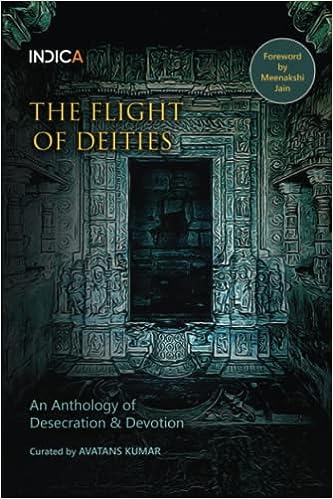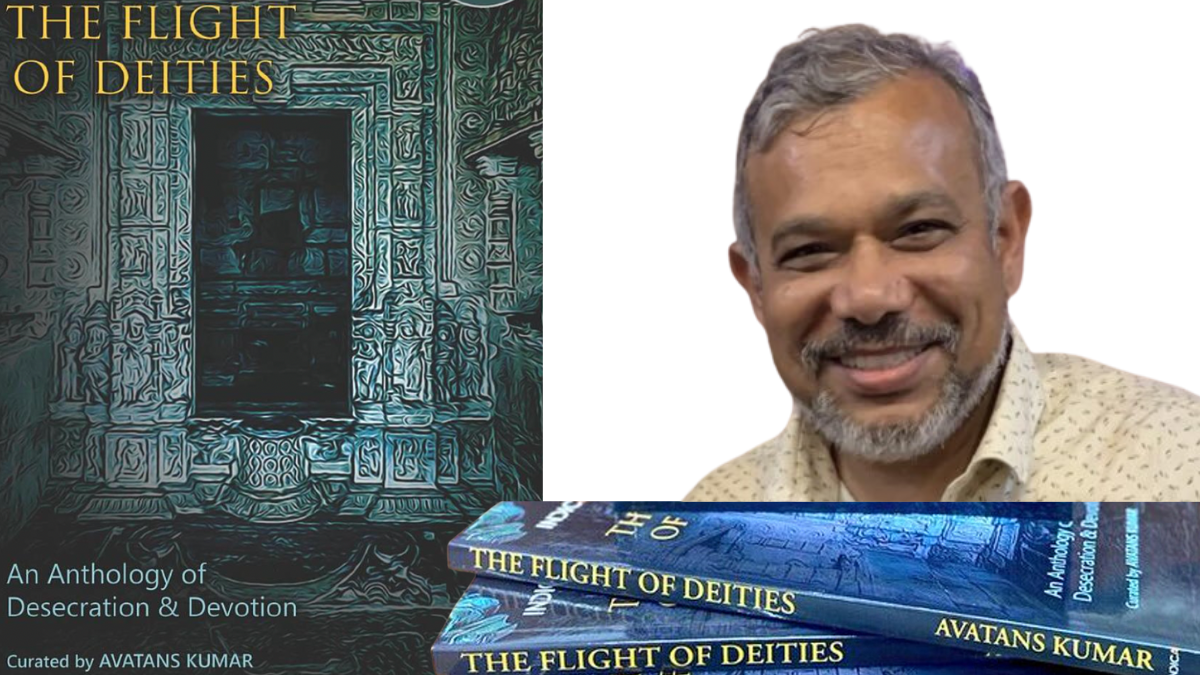
People who have suffered intense trauma don’t want to talk about it. They don’t want to listen to stories that remind them of their trauma
By Manjula Tekal
The destruction of deities
People who have suffered intense trauma don’t want to talk about it. They don’t want to listen to stories that remind them of their trauma. But they cannot become fully functional unless they confront their pain.
Avatans Kumar says in his preface, “For Indians, Hindus specifically, the massive destruction of temples and the desecration and dismemberment of their deities throughout the past millennia has been an acute source of transgenerational trauma. The fact that no standing grand ancient Hindu temple older than about a hundred years exists in and around the National Capital Region of Delhi accentuates this trauma.” And Delhi is an ancient capital of a nation that is thousands of years old!
Until recently, we Hindus were not allowed to talk about our pain because of various political and economic pressures. Our stories were buried, our history was distorted, and we bore our anguish in silence.
A welcome catharsis
This book, “The Flight of Deities: An Anthology of Desecration and Devotion,” comes as a welcome catharsis.
Professor Meenakshi Jain, whose book, The Flight of the Deities, has inspired this anthology has written a beautiful foreword.
I started reading the book expecting to find a collection of historical narrative stories about the attacks on temples and the desecration of deities. Yes, the stories are about the flight of deities, but they are more narratives highlighting the human aspects of sacrifice, unswerving devotion, and steadfast stoicism and hope in the face of defeat.
Lost images of Vishnu
Surela Chakraborty narrates the story of a brilliant, passionate, and introverted young archaeologist who sees visions of a lost image of Vaikuntha Vishnu while working at the temple in Khajuraho. His efforts to recover the image fail tragically. The story is abundantly interspersed with many factoids about Khajuraho’s history.
Devamalya De’s Thakurji’s Promise is the story of the Rajputs saving the image of Srinathji from desecration and taking Him away from Govardhan to Rajputana. The author also narrates how Srinathji decided to settle in Nathdwara and how the Rajputs built a temple for Srinathji there.
Kavita Meegama’s Multan, Sindh, is a heartrending tale of abduction and forced conversion in the backdrop of the desecration of the Multan temple, narrated with great sensitivity
 The temple in Multan
The temple in Multan
Kavita Meegama’s Multan, Sindh, is a heartrending tale of abduction and forced conversion in the backdrop of the desecration of the Multan temple, narrated with great sensitivity. The abduction of the protagonist’s mother, who belongs to the family of caretakers of the temple in Multan, and the intolerable personal truth that the protagonist himself must face are only hinted at, adding to the poignancy of the narration.
However, as a reader, I question that allegiance to one’s faith lasts beyond a couple of generations. The intergenerational turmoil must surely be tempered with a certain degree of rationalization and retrospective falsification. Still, the story tugged at my heartstrings. I particularly loved how the story ends, with an act of small defiance that acknowledges a profound change within while implicitly hinting at the protagonist’s regret at his inability to effect any real difference at a macro level.
Invasions of Jagganath Puri
Aneesh Gokhale’s Eighteen Invasions of Jagannath Puri is an account of the brutal invasion of the Konark Sun temple. The Aruna stambha of Konark is relocated to Puri by the Marathas. A reader understands that the history of the kingdoms is irrevocably intertwined with the history of its temples—there is no way to secularize this knowledge. It is much more the wealth held by the temple. I resonated with the evident pride that the author feels for his ‘tenacious Maratha ancestors.’
Mahabharata-era Shivalings
The Fellowship of the Shivalinga is an action-packed story set in the times of later Mughals of a thrilling rescue of a Rajput princess and Mahabharata-era Shivalings. Pranshu Saxena packs an incredible amount of history in his story while maintaining the continuous flow of history from the times of Mahabharat to the time of the story with ease. The politics and intrigues of Faruksiyar’s court keep the reader engaged and guessing. I was left wondering about the story of Nawab Bai Nee Anuradha Bai Sahiba, who claimed direct descent from Janamejaya of the Mahabharata. Perhaps her story is another that must be told! Muazzam alias Bahadur Shah was enamored of tales from the Puranas, a character in the story informs us! Another story that perhaps needs to be examined on its own is the story of Princess Inder Kanwar.
Pranshu Saxena also examines the moral quandary of a soldier engaged in the rescue mission. “Those who cannot create have no right to destroy.” What is the right dharma? Though the story is simple, it is thought-provoking and dense with detail.
Reprise and Remorse
Reprise by Aditi Gopinath is an evocative story that captures the somber mood of a venal man suffering the torments of remorse in his final hours for betraying his parents and Ma Saraswati during the pillage of Martanda temple in Kashmir.
The Language of the Deities, a charming story about the flight of Radharani and Govindadeva from Vrindavan written by Aditi Banerjee, poignantly brings home to the reader that home is where the heart is. You feel that even Gods feel the pangs of dispossession when being forced out of their home. The story is multilayered and narrated in a voice that is surprisingly devoid of melancholy or melodrama. There is an emotional pull of a lost language, the sounds of the Yamuna flowing nearby, and the fragrance of Bakula flowers. The strong force the protagonist feels to search for the Bakula tree, even at the cost of renouncing his dreams, is narrated with compassion. The protagonist’s vision is not some hyper-imagination of a fevered brain but is deductively reasoned out. “For me to have imagined it, I must have known about the Bakula tree next to their temple in Vrindavan. But I do not even know what a Bakula tree looks like.”
The protagonist is successful in his mission but throws away everything he has achieved in a fit of anger. And Lord Govindadeva says, “I know what he could be, but not what he would be. That was always up to him.” Is the author indicating that even providence does not know the final outcome of an action? All in all, a very thought-provoking and enjoyable read.
Murtis in Madurai
Agyaatvaas by Shubhra Prakash is about a student of temple architecture whose passionate objective is to find and liberate the murtis in agyaatvaas.
There are two stories in the anthology about Madurai Meenakshi. The first, The Will of Gods by Rajesh Ramachander, chronicles Malik Kafur’s invasion of Madurai and the desperate defense put up by Veera Pandyan. In the first of several attacks, Kafur’s army burns the Meenakshi temple, and the old head priest is burnt in the fire. But after several such attacks, the Pandyas are weakened, and the deities must be secreted away to safety. Decades later, the deities would be welcomed back to their home in Madurai by the Vijayanagar king. Despite the many battles and loss of life, a whiff of romance and triumph in this story made me happy.
The second story about the Islamic invasion of Madurai, The Queen of Madurai, is written by Deepa Doraiswamy. Told from the point of view of a young grandson of the temple priest, it is the magical story of how Kampana reinstated original deities. I loved how the author interspersed verses from Lalitha Sahasranamam to underscore her ideas. It is a pleasure to read narratives rich in cultural references. From her notes, I learned that the author also liberally quotes from Madhura Vijayam by Queen Ganga Devi. She also offers some deep philosophical insights. “Have I not taught you well, Sarva? The linga is the instrument. We invoke the lord in the linga—the body can break; the spirit cannot.” Even after completing the book, this poignant story lingered in my mind.
_____________________
 Manjula Tekal is an author and translator. She has several translations to her credit, including Kannada translation of Jagmohan’s My Frozen Turbulence in Kashmir, Babu Krishnamurthy Ajeya, biography of Chandrashekhar Azad, from Kannada to English (releasing soon), and Sankrant Sanu The English Medium Myth in Kannada. Manjula holds Masters’ degrees in management from the Indian Institute of Management, Bangalore, and the University of Illinois at Urbana-Champaign, and has worked in Fortune 100 companies.Manjula’s early influences included her father, who fostered a sense of pride in her heritage and respect for independent thought, and her mother, who loved literature. She lives with her husband and two children in Illinois, USA. Devayani is her debut novel.
Manjula Tekal is an author and translator. She has several translations to her credit, including Kannada translation of Jagmohan’s My Frozen Turbulence in Kashmir, Babu Krishnamurthy Ajeya, biography of Chandrashekhar Azad, from Kannada to English (releasing soon), and Sankrant Sanu The English Medium Myth in Kannada. Manjula holds Masters’ degrees in management from the Indian Institute of Management, Bangalore, and the University of Illinois at Urbana-Champaign, and has worked in Fortune 100 companies.Manjula’s early influences included her father, who fostered a sense of pride in her heritage and respect for independent thought, and her mother, who loved literature. She lives with her husband and two children in Illinois, USA. Devayani is her debut novel.
Courtesy: India Currents (Posted on August 13, 2023)